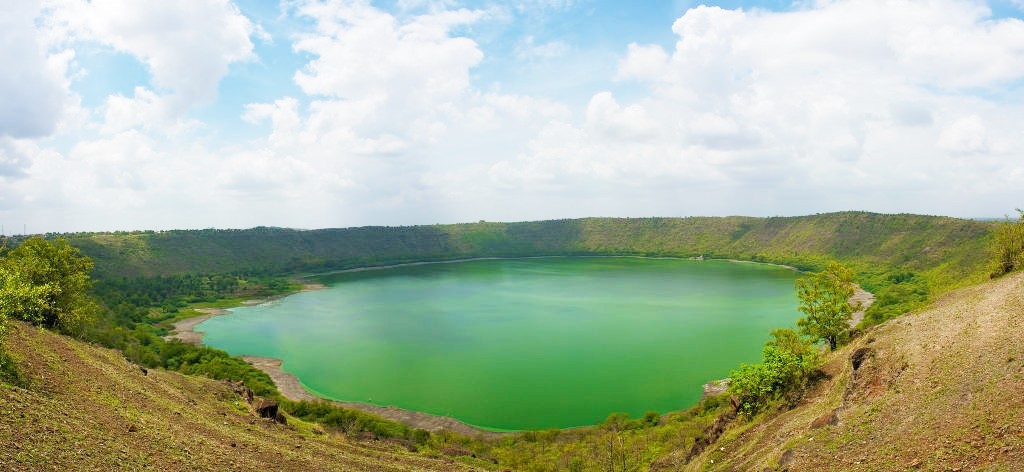20 Best Places to Visit in June in India
June marks the onset of early monsoon in many parts of India, making it one of the most refreshing months for nature lovers. It is...

Lonar Lake, an emerald-green colored lake in the Buldhana district of Maharashtra, is no less than a mystery for its visitors. It is believed that around 52,000 years ago, the largest ever high-velocity meteorite hit the earth, weighing around two million tonnes. This meteorite created a 1.8 kilometer wide and 150-meter deep crater and with time, this place turned into a lush forest with a tranquil stream, now called the Lonar Lake.
A few fascinating bits about the lake is that it’s saline and alkaline at the same time and bears micro-organisms hardly found on earth. There is so much to talk about this lake. It definitely holds many secrets beneath it. Have you wondered why this lake is green in color? Let’s read why:
According to studies, the Lonar Lake became green in color due to the accumulation of sewage waste and refuse waste of Lonar town, causing formation of blue-green algae (aquatic plant life forms).
As per the locals, it is named after the demon “Lonasura”. The crater formed because of the meteorite, which was then the home (den) of Lonasura and the lake’s gloomy water is because of his spilled blood. This lake is not just a mystery but also has rich heritage character as it is surrounded by temples dating back to about 2,000 years. This is why; it continues to attract tourists and scientific communities from around the world.
During the summer season, the weather is unbearably hot around the lake. Hence, the best time to visit the Lonar Lake is November to January so that you can enjoy a pleasant weather while taking a walk around the lake.

1. You can choose to trek to this magnificent astronomical miracle. However, it is a difficult one as it has slippery paths. Also, the trek route is laden with lush greenery powdered with rich minerals and centuries-old ruined temples.

2. If you have an interest in bird-watching then you can sight bird species such as blue jays, barn owls, pea fowl, red-wattled lapwings, hoopoes, shelduck, golden oriole and many more. The jungle surrounding the lake is home to bright-colored insects, mongoose, snakes, scorpions, chinkara and gazelle. It is an all-in-one scientific, wildlife and adventure journey for you.

3. Ram Gaya Temple (signifying the exit of Lord Rama), Sita Nahani temple (believed to be the bath place of Sita ), the Daitya Sudan temple (in honor of Lord Vishnu for killing the demon Lonasura) and Shankar Ganesha temple (for its spectacular Shiva idol) are a must-watch religious attractions for history lovers.
Note: You should avoid contact with the water of this lake has pH of 10 that cause serious rashes or burns.
Aurangabad located in Maharashtra provides public transport to reach here. Book a flight to Aurangabad or Chikkalthana Airport (around 157 km away from the lake). Once you deboard, you will get plenty transportation facilities to reach the lake.
By Rail:
The closest rail head is Jalna, a district in Maharashtra. Board a train to Jalna and once you deboard, you will get many public transport options to reach the lake, which is about 90 km away.
Tourists who visit nearby Aurangabad, usually visit the UNESCO sites – Ajanta and Ellora Caves (rock-cut caves) – but this lake remains unexplored. The splendid view of this lake is one-of-a-kind that will give wings to your imagination. Besides its mysterious existence, this lake is a natural charm as well. Its exceptional and mind boggling history makes this lake perfect spot for every traveler!
So next time you head for a vacation, make sure this place is on your bucket list!
June marks the onset of early monsoon in many parts of India, making it one of the most refreshing months for nature lovers. It is...
May is one of the most exciting months to explore India, as it marks the transition from the pleasant spring months to the onset of...
April marks the beginning of summer across the country, making it one of the most exciting months to travel. With blooming valleys, pleasant hill stations,...
You are one step closer to having the best journey of your lifetime! Talk to us, write to us all that you have envisioned for your India trip, and one of our travel experts will connect with you on priority. To help you explicitly we have WhatsApp and Email addresses!